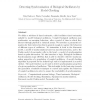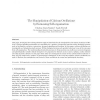9 search results - page 1 / 2 » Detecting synchronisation of biological oscillators by model... |
TCS
2010
13 years 3 months ago
2010
We define a subclass of timed automata, called oscillator timed automata, suitable to model biological oscillators. Coupled biological oscillators may synchronise, as emerging be...
ACSC
2010
IEEE
12 years 11 months ago
2010
IEEE
The importance of networks of coupled oscillators is widely recognized. Such networks occur in biological systems like the heart, in chemical systems, in computational problems, a...
BIOSYSTEMS
2008
13 years 4 months ago
2008
This paper investigates how self-organisation might be harnessed for the manipulation and control of calcium oscillations. Calcium signalling mechanisms are responsible for a numb...
CMSB
2009
Springer
13 years 11 months ago
2009
Springer
Circadian clocks are biochemical networks, present in nearly all living organisms, whose function is to regulate the expression of specific mRNAs and proteins to synchronise rhyth...
GCB
2009
Springer
13 years 8 months ago
2009
Springer
Abstract: It is often challenging to reconstruct accurately a complete dynamic biological network due to the scarcity of data collected in cost-effective experiments. This paper ad...



